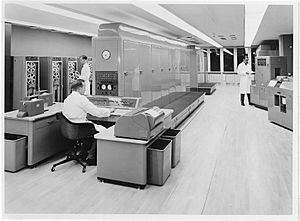Ferranti Perseus facts for kids
Perseus was an early computer built in Great Britain by a company called Ferranti. It was a "vacuum tube" computer, meaning it used special glass tubes (like old light bulbs) instead of the tiny chips we have today.
The Perseus computer was an improved version of another Ferranti computer called Ferranti Pegasus. It was made especially for handling huge amounts of information for businesses. This was Ferranti's first computer built specifically for companies to use. It had a special way to check its own work automatically. Only two Perseus computers were sold, both in 1959, to insurance companies in other countries.
Contents
How the Perseus Computer Worked
The Perseus computer was designed to handle a lot of information for businesses. It had two main parts that worked separately.
The Brain of the Computer
One part was the main computer itself. This was like the "brain" that processed all the information. It was built using the same kind of electronic parts as the Ferranti Pegasus computer.
Handling Information and Printing
The other part was a special unit for printing. This unit could read information from half-inch wide magnetic tape. Imagine these tapes like very old-fashioned computer files.
The main goal for Perseus was to manage huge amounts of data, not to do complex science calculations. It used magnetic tapes to store and access all this information.
Memory and Storage
The computer had a special type of memory called "delay lines." These were like short tubes that could hold small bits of information temporarily. It had 160 "words" of fast memory. A "word" is a group of bits, and for Perseus, each word was 72 bits long.
For even more storage, it used many more delay lines. These could store a total of 864 "words" of information.
Getting Information In and Out
To put information into the computer, people used "punched card readers." These machines could read data from cards with holes punched in them.
To get information out, the computer would send it to magnetic tapes. Then, a separate machine would read these tapes and print the information using fast "line printers." These printers could print 300 lines of text every minute!
Images for kids



